Research of Load Impact on Energy Consumption in an Electric Delivery Vehicle Based on Real Driving Conditions: Guidance for Electrification of Light-Duty Vehicle Fleet
Abstract
1. Introduction
2. Survey Assessment: Guidelines and Demand of Transport Companies for Electromobility
2.1. Questionnaire Design
2.2. Data Collection
2.3. Data Analysis
2.4. Conclusions
- Light-duty vehicles are currently predominantly equipped with CI Engines. The usage of electric motor is still modest—declared by only 3% of the respondents.
- Almost a third of the respondents declared the average daily distance covered being greater than 230 km, which is the range declared by the manufacturer for the Toyota Proace Electric with a 50 kWh battery.
- The cargo van is the most frequently chosen light-duty vehicle body type.
- Government subsidies for purchasing electric cars, free charging stations and allowance for bus lane usage proved to be the most efficient ways to raise interest in electromobility.
3. Research Object
4. Measurement Route and Conditions
5. Research Results
6. Summary
- The maximum range of the LDV in actual traffic conditions differs from the declared by the manufacturer (330 km WLTP), both in unloaded and fully loaded trips (by 15% and 22%, respectively).
- The vehicle’s weight increased by 850 kg of loading affects the range reduction as summarized in Figure 22. The largest decrease (by almost 14%) in range was recorded for the urban route, due to increased energy consumption during acceleration.
- The impact of route type (average speed and proportion of recuperation) significantly affects the vehicle range—differences between highway and urban routes reach 25–30%.
- In an urban application, an electric delivery vehicle will meet most of the transportation requirements among surveyed entrepreneurs.
- The delivery vehicle should be adapted to the daily operation of the company. This may allow to reduce the battery capacity (reduce the purchase price) or increase the battery charging intervals. This applies to companies that declare a daily distance in the range of up to 100 km.
- Variable loading has an impact on the maximum range of the vehicle during the day, and proper planning of unloading from the heaviest goods can greatly increase the range of the vehicle.
- The delivery electric vehicle should be used especially in urban transportation, as the energy recuperation significantly reduces the energy consumption of the vehicle.
Author Contributions
Funding
Data Availability Statement
Acknowledgments
Conflicts of Interest
Abbreviations
| BEV | battery electric vehicle |
| CAN | controller area network |
| EV | electric vehicle |
| FCEV | fuel cell electric vehicle |
| HEV | hybrid electric vehicles |
| ICE | internal combustion engine |
| LCA | life-cycle assessment |
| NEDC | New European Driving Cycle |
| PHEV | plug-in hybrid electric vehicles |
| RDC | real driving conditions |
| SOC | state of charge |
| TTW | tank to wheel |
| WLTP | Worldwide Harmonised Light Vehicles Test Procedure |
References
- Clean and Sustainable Mobility. Available online: https://www.consilium.europa.eu/en/policies (accessed on 27 November 2022).
- Carbon Dioxide Emissions from Europe’s Heavy-Duty Vehicles. Available online: https://www.eea.europa.eu/publications (accessed on 27 November 2022).
- Weiss, M.; Cloos, K.C.; Helmers, E. Energy efficiency trade-offs in small to large electric vehicles. Environ. Sci. Eur. 2020, 32, 46. [Google Scholar] [CrossRef]
- Zhao, C.; Gong, G.; Yu, C.; Liu, Y. Research on Key Factors for Range and Energy Consumption of Electric Vehicles. SAE Technical Paper 2019-01-0723. 2019. [Google Scholar] [CrossRef]
- Bull, M. Mass Reduction Performance of PEV and PHEV Vehicles. 22nd Enhanced Safety of Vehicle Conference, Washington, 2011. Available online: https://www-esv.nhtsa.dot.gov/Proceedings/22/ (accessed on 10 November 2022).
- Ziemba, P.; Gago, I. Compromise Multi-Criteria Selection of E-Scooters for the Vehicle Sharing System in Poland. Energies 2022, 15, 5048. [Google Scholar] [CrossRef]
- Turoń, K.; Kubik, A.; Chen, F. What Car for Car-Sharing? Conventional, Electric, Hybrid or Hydrogen Fleet? Analysis of the Vehicle Selection Criteria for Car-Sharing Systems. Energies 2022, 15, 4344. [Google Scholar] [CrossRef]
- Turoń, K.; Kubik, A.; Ševčovič, M.; Tóth, J.; Lakatos, A. Visual Communication in Shared Mobility Systems as an Opportunity for Recognition and Competitiveness in Smart Cities. Smart Cities 2022, 5, 802–818. [Google Scholar] [CrossRef]
- Aiello, G.; Quaranta, S.; Certa, A.; Inguanta, R. Optimization of Urban Delivery Systems Based on Electric Assisted Cargo Bikes with Modular Battery Size, Taking into Account the Service Requirements and the Specific Operational Context. Energies 2021, 14, 4672. [Google Scholar] [CrossRef]
- More Customers Are Shopping Online Now Than at Height Of Pandemic, Fueling Need For Digital Transformation. Available online: https://www.forbes.com/sites/blakemorgan/2020/07/27/more-customers-are-shopping-online-now-than-at-height-of-pandemic-fueling-need-for-digital-transformation/?sh=768cdf076bb9 (accessed on 24 November 2022).
- Sánchez, D.G.; Tabares, A.; Faria, L.T.; Rivera, J.C.; Franco, J.F. A Clustering Approach for the Optimal Siting of Recharging Stations in the Electric Vehicle Routing Problem with Time Windows. Energies 2022, 15, 2372. [Google Scholar] [CrossRef]
- Erdelić, T.; Carić, T. Goods Delivery with Electric Vehicles: Electric Vehicle Routing Optimization with Time Windows and Partial or Full Recharge. Energies 2022, 15, 285. [Google Scholar] [CrossRef]
- Iwan, S.; Nürnberg, M.; Bejger, A.; Kijewska, K.; Małecki, K. Unloading Bays as Charging Stations for EFV-Based Urban Freight Delivery System—Example of Szczecin. Energies 2021, 14, 5677. [Google Scholar] [CrossRef]
- Martins, L.d.C.; Tordecilla, R.D.; Castaneda, J.; Juan, A.A.; Faulin, J. Electric Vehicle Routing, Arc Routing, and Team Orienteering Problems in Sustainable Transportation. Energies 2021, 14, 5131. [Google Scholar] [CrossRef]
- Wang, L.; Wu, Z.; Cao, C. Integrated Optimization of Routing and Energy Management for Electric Vehicles in Delivery Scheduling. Energies 2021, 14, 1762. [Google Scholar] [CrossRef]
- Baek, D.; Chen, Y.; Chang, N.; Macii, E.; Poncino, M. Battery-Aware Electric Truck Delivery Route Exploration. Energies 2020, 13, 2096. [Google Scholar] [CrossRef]
- Zardini, A.; Bonnel, P. Real Driving Emissions Regulation: European Methodology to Fine Tune the EU Real Driving Emissions Data Evaluation Method, EUR 30123 EN; Publications Office of the European Union: Luxembourg, 2020; ISBN 978-92-76-17157-7. [Google Scholar] [CrossRef]
- Szałek, A.; Pielecha, I.; Cieslik, W. Fuel Cell Electric Vehicle (FCEV) Energy Flow Analysis in Real Driving Conditions (RDC). Energies 2021, 14, 5018. [Google Scholar] [CrossRef]
- Al-Wreikat, Y.; Sodre, J. Evaluating the Energy Consumption of an Electric Vehicle Under Real-World Driving Conditions. SAE Technical Paper 2022-01-1127. 2022. [Google Scholar] [CrossRef]
- Cieślik, W.; Szwajca, F.; Golimowski, J. The possibility of energy consumption reduction using the ECO driving mode based on the RDC test. Combust. Engines 2020, 182, 59–69. [Google Scholar] [CrossRef]
- Pielecha, I.; Cieslik, W.; Szalek, A. Impact of Combustion Engine Operating Conditions on Energy Flow in Hybrid Drives in RDC Tests. SAE Technical Paper 2020-01-2251. 2020. [Google Scholar] [CrossRef]
- Andrych-Zalewska, M.; Chlopek, Z.; Merkisz, J.; Pielecha, J. Comparison of Gasoline Engine Exhaust Emissions of a Passenger Car through the WLTC and RDE Type Approval Tests. Energies 2022, 15, 8157. [Google Scholar] [CrossRef]
- Pielecha, J.; Skobiej, K.; Gis, M.; Gis, W. Particle Number Emission from Vehicles of Various Drives in the RDE Tests. Energies 2022, 15, 6471. [Google Scholar] [CrossRef]
- Pielecha, I.; Szałek, A.; Tchorek, G. Two Generations of Hydrogen Powertrain—An Analysis of the Operational Indicators in Real Driving Conditions (RDC). Energies 2022, 15, 4734. [Google Scholar] [CrossRef]
- Selleri, T.; Melas, A.D.; Franzetti, J.; Ferrarese, C.; Giechaskiel, B.; Suarez-Bertoa, R. On-Road and Laboratory Emissions from Three Gasoline Plug-In Hybrid Vehicles—Part 1: Regulated and Unregulated Gaseous Pollutants and Greenhouse Gases. Energies 2022, 15, 2401. [Google Scholar] [CrossRef]
- Melas, A.; Selleri, T.; Franzetti, J.; Ferrarese, C.; Suarez-Bertoa, R.; Giechaskiel, B. On-Road and Laboratory Emissions from Three Gasoline Plug-In Hybrid Vehicles—Part 2: Solid Particle Number Emissions. Energies 2022, 15, 5266. [Google Scholar] [CrossRef]
- Pielecha, J.; Skobiej, K.; Kubiak, P.; Wozniak, M.; Siczek, K. Exhaust Emissions from Plug-in and HEV Vehicles in Type-Approval Tests and Real Driving Cycles. Energies 2022, 15, 2423. [Google Scholar] [CrossRef]
- Electromobility Meter: On Polish Roads in 2021. Available online: https://www.pzpm.org.pl/pl/Rynek-motoryzacyjny/Licznik-elektromobilnosci/Rok-2021/Grudzien-2021 (accessed on 24 November 2022).
- Electric Vans—Will They Manage to Meet the Demands of the Modern World—Toyota Proace EV. Available online: https://youtu.be/Y6kQzUP2CBw (accessed on 10 November 2022).
- Toyota Proace Electric. Available online: https://www.toyota.co.uk/new-cars/proace-ev (accessed on 24 November 2022).
- Electric Vehicle Database. Available online: https://ev-database.org/ (accessed on 10 November 2022).
- Proace EV Service Manuals. Available online: https://www.techdoc-toyota.com (accessed on 10 November 2022).
- Gis, W.; Pielecha, J.; Merkisz, J.; Kruczyński, S.; Gis, M. Determining the route for the purpose light vehicles testing in Real Driving Emissions (RDE) test. Combust. Engines 2019, 178, 61–66. [Google Scholar] [CrossRef]
- Weather Archive. Available online: https://www.weatheronline.pl/weather/maps/city (accessed on 10 November 2022).

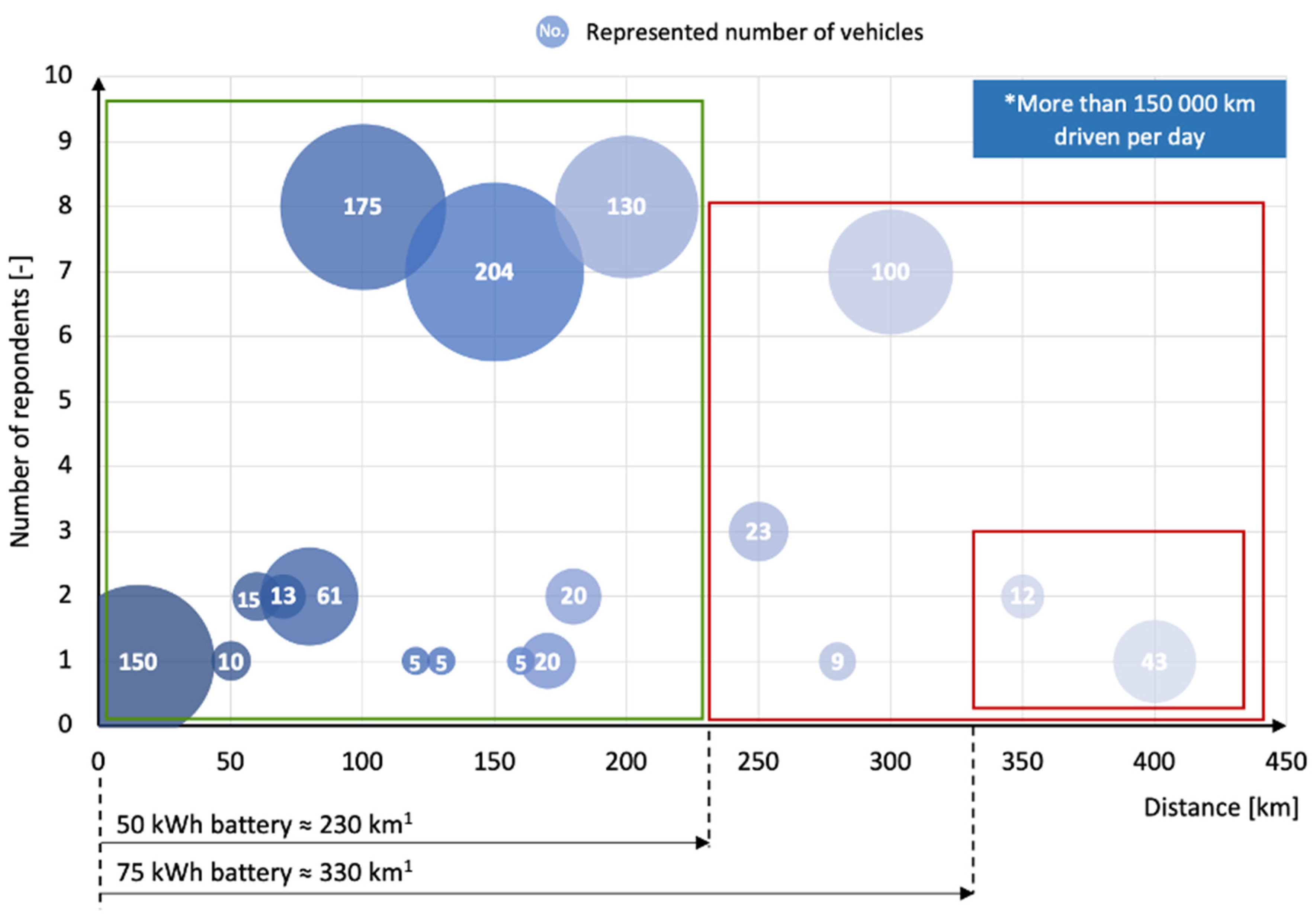
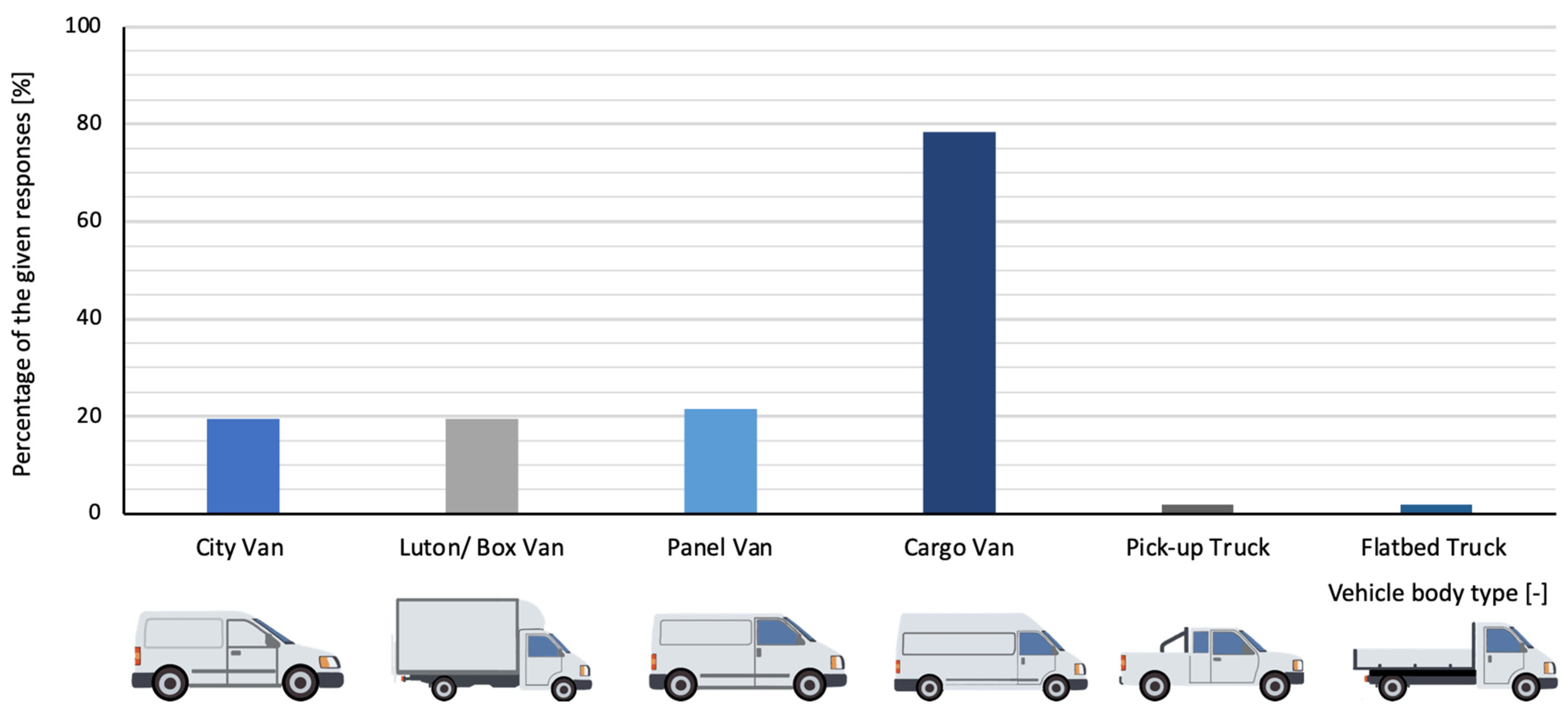

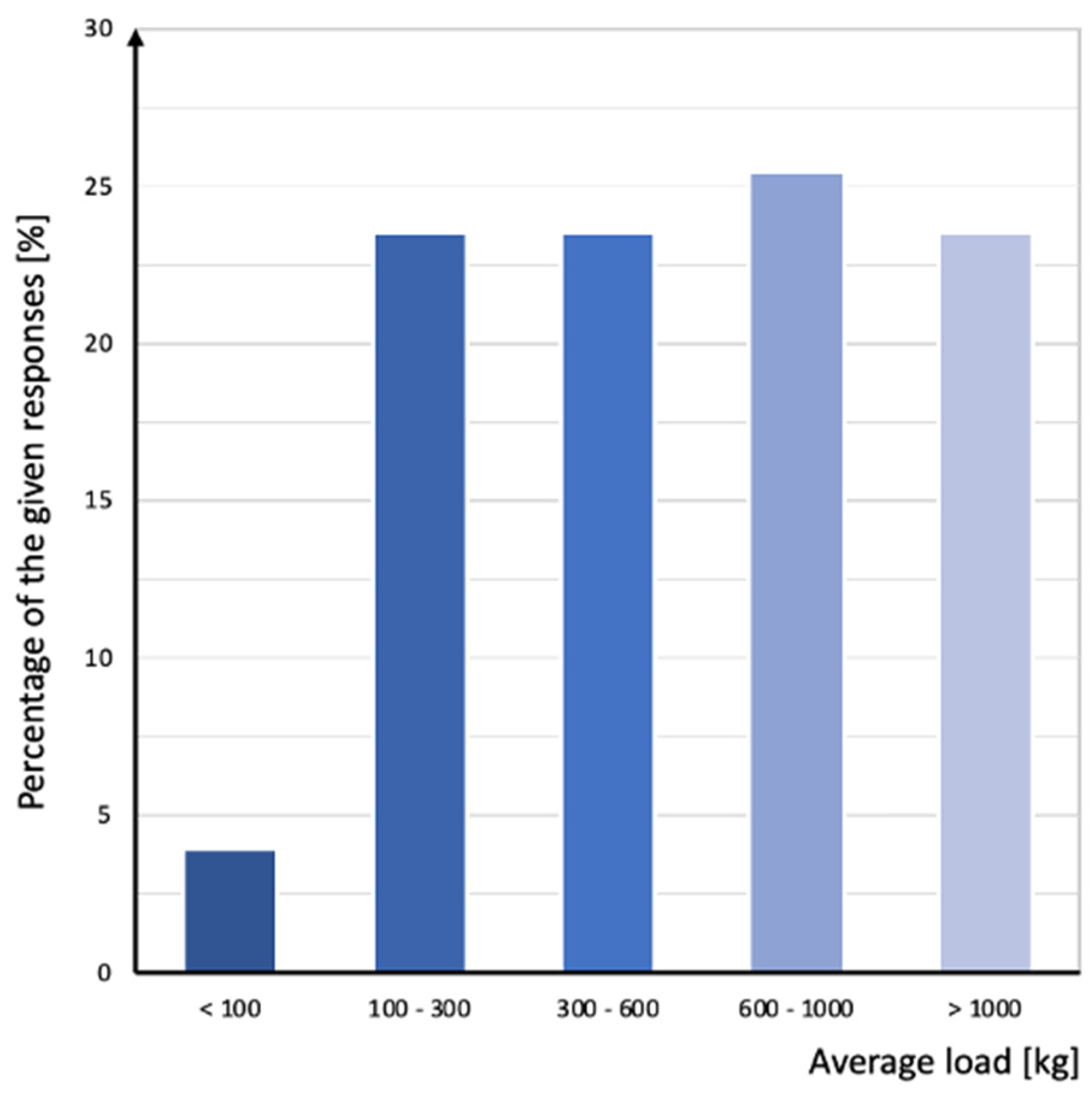
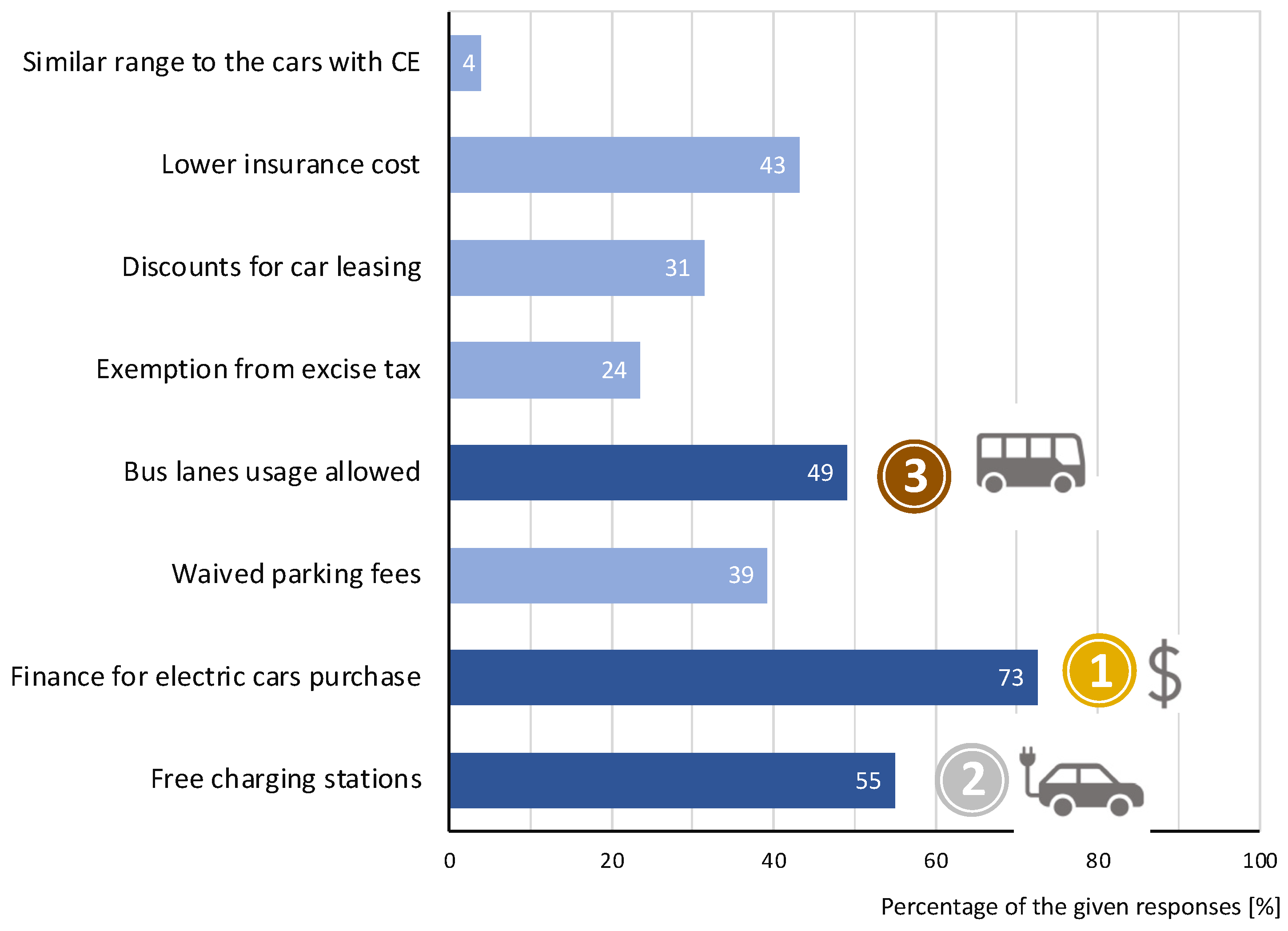

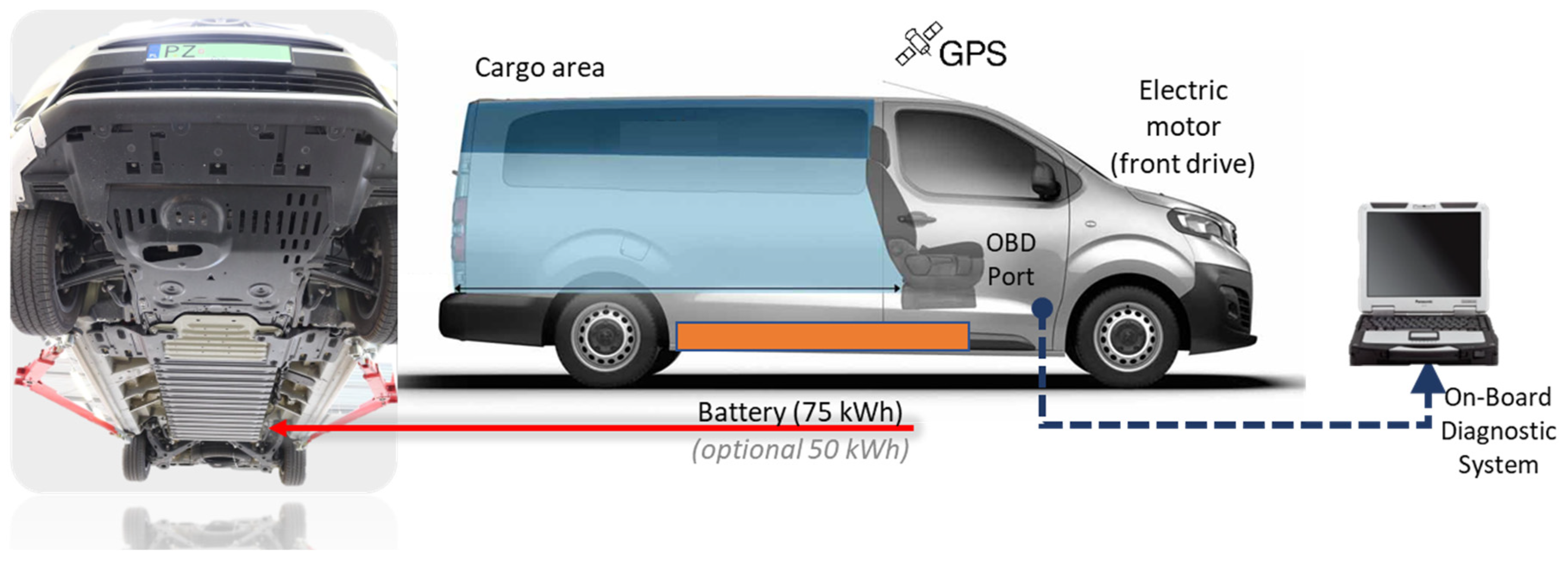
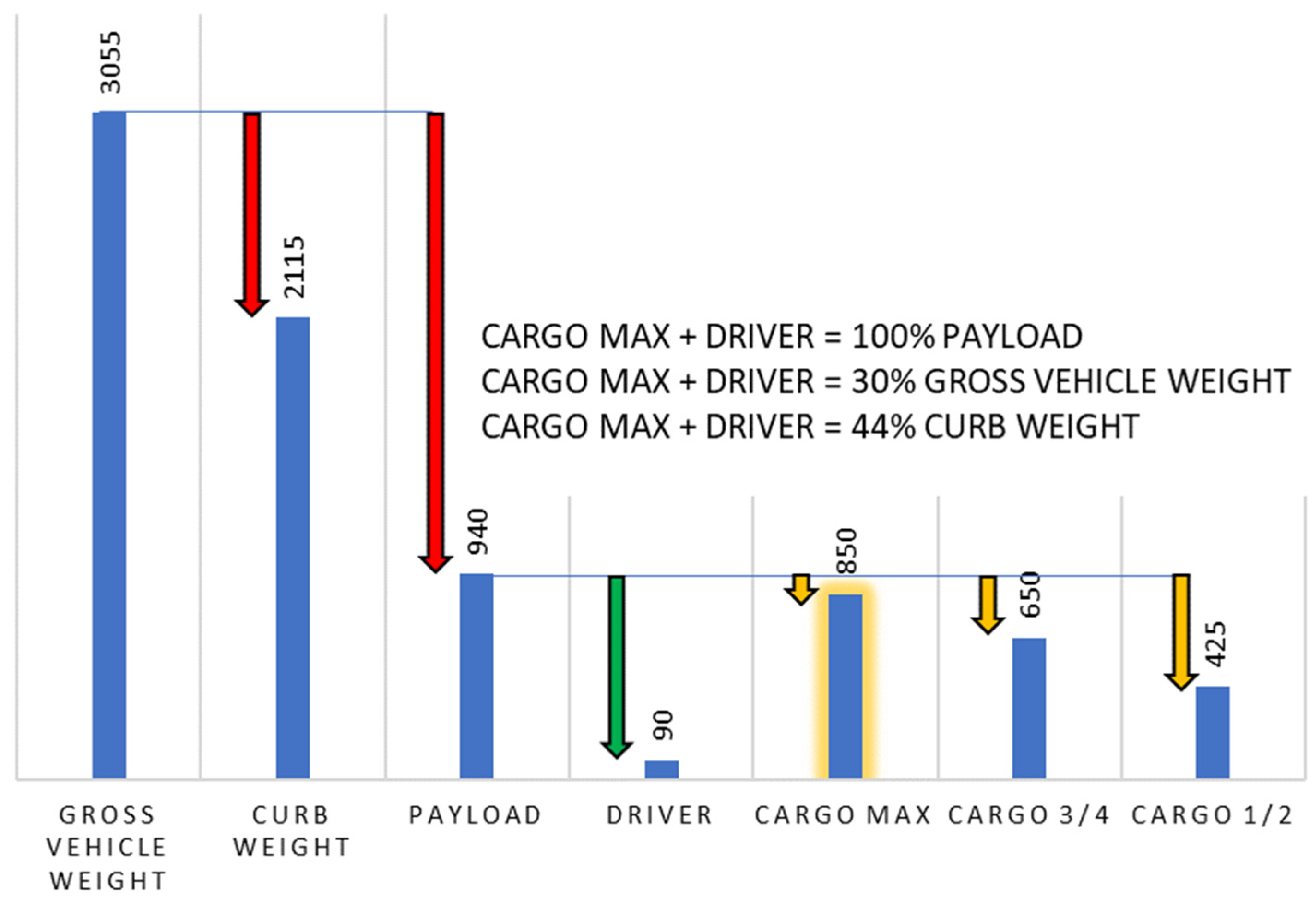


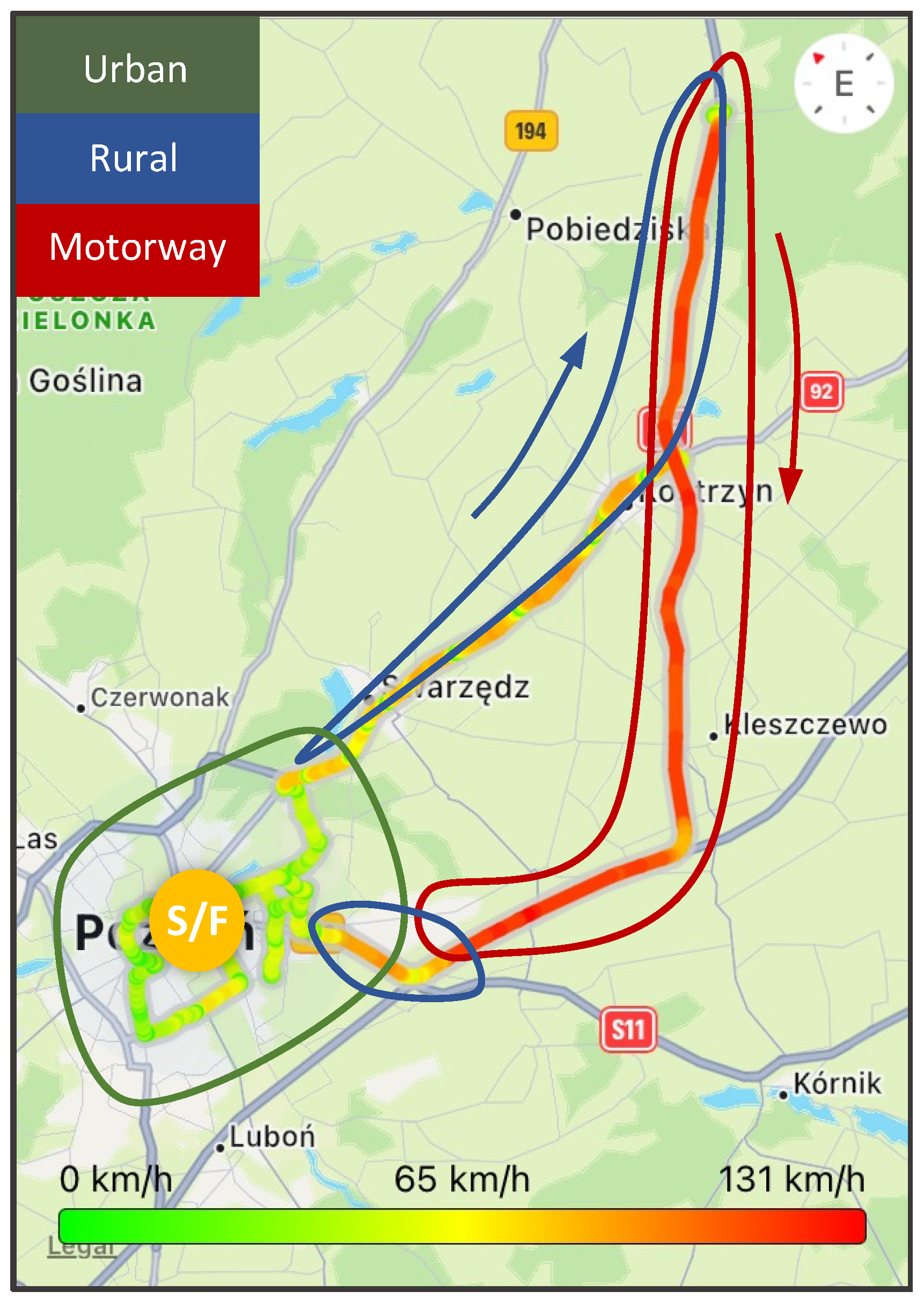

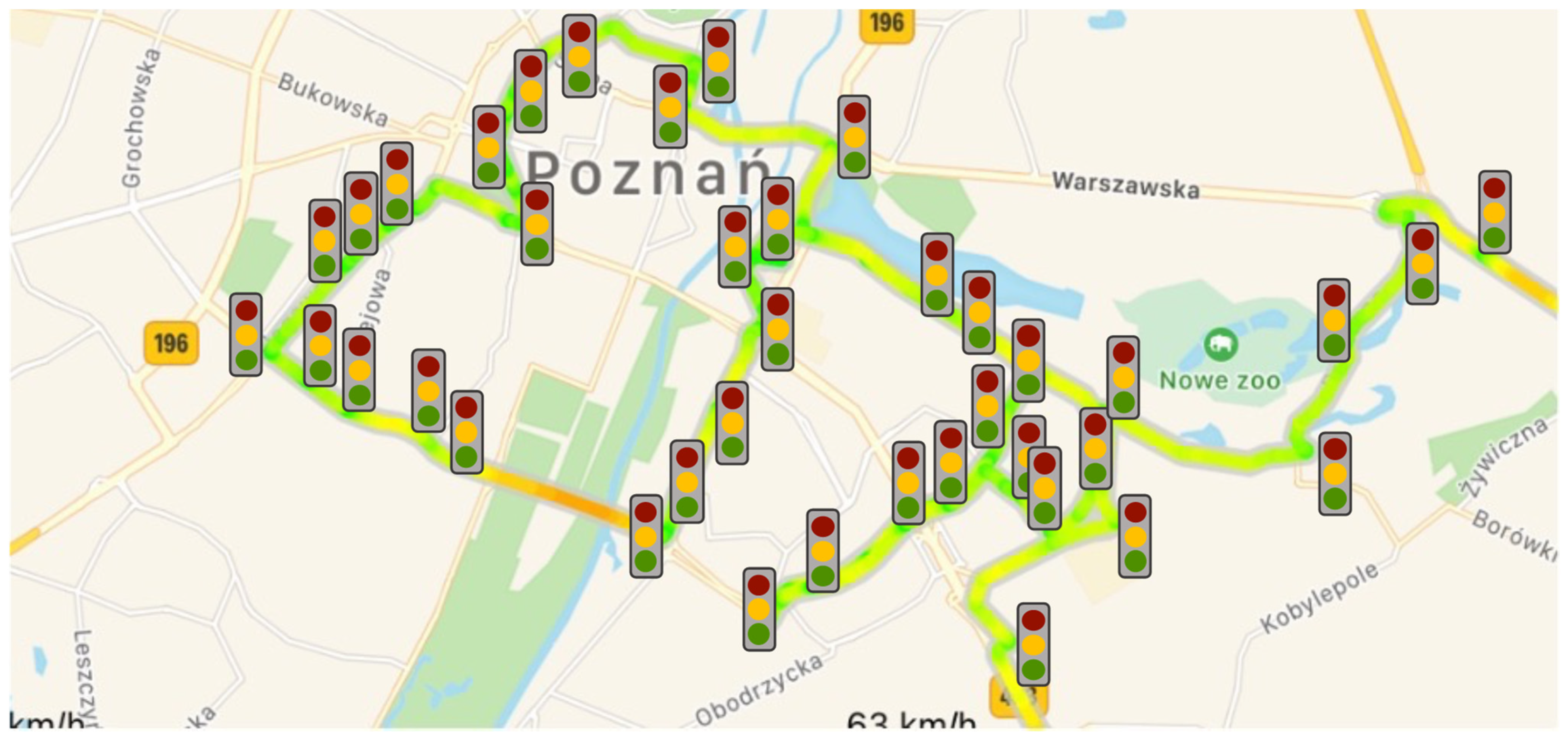

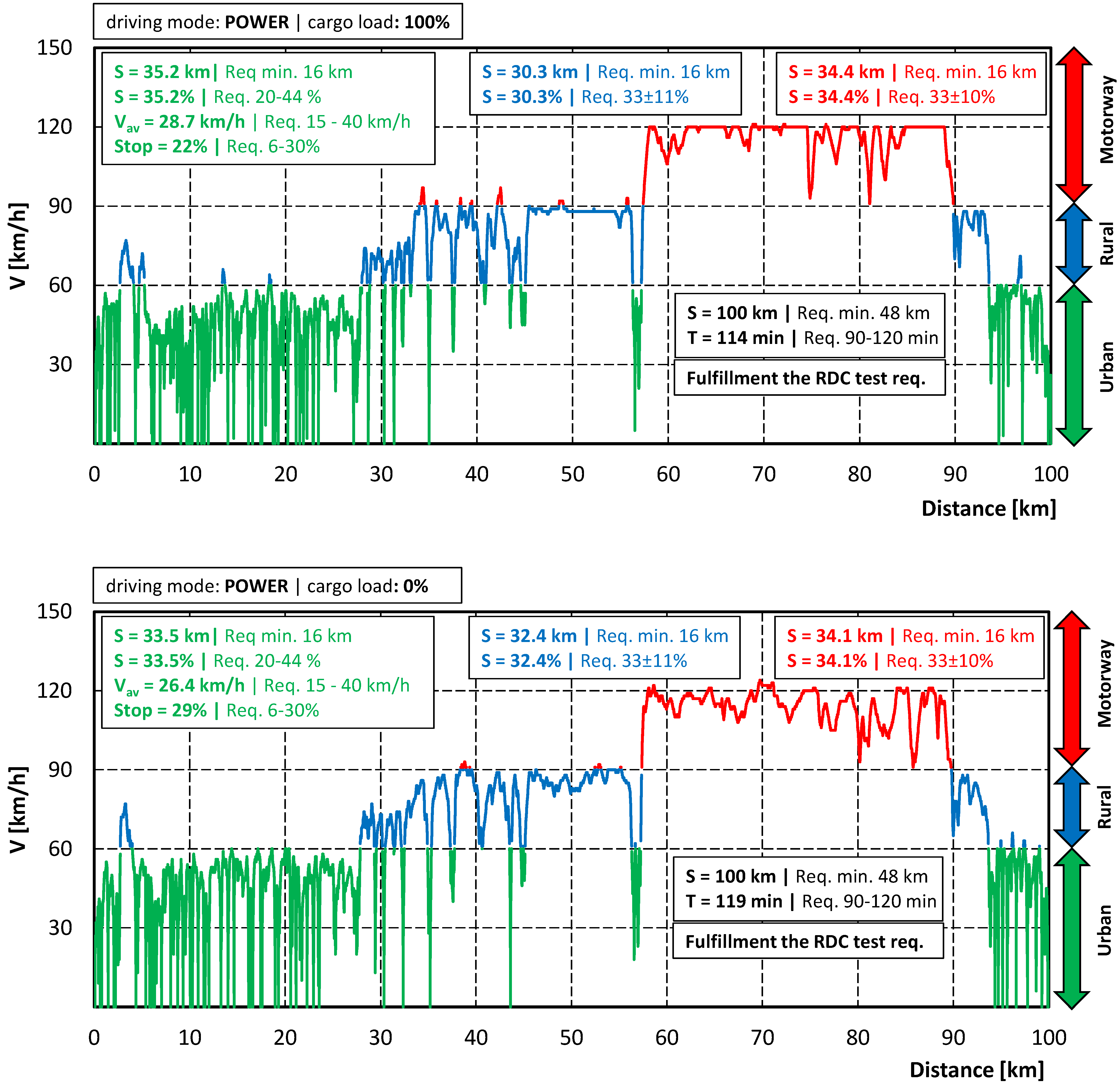





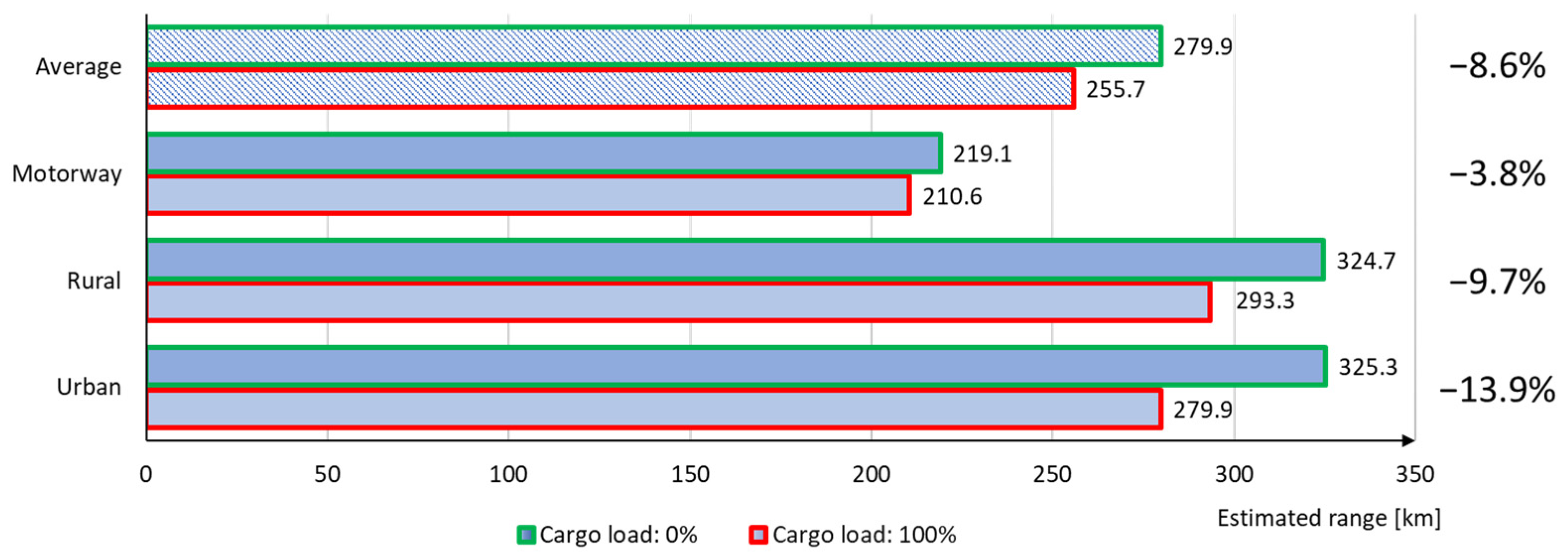
| Type of Vehicle | 2019 | 2020 | 2021 | November 2022 |
|---|---|---|---|---|
| Passenger EV | 5091 | 10,041 | 18,795 | 28,386 |
| Passenger PHEV | 3546 | 8834 | 19,206 | 28,540 |
| Large EV | 5191 224 2 | 8391 430 2 | 16571 651 2 | 26381 790 2 |
| Small EV 3 | 6450 | 9308 | 11,091 | 16,541 |
| FCEV | 1 | 0 | 79 | 124 |
| Selected RDE/RDC Test Requirements | Urban | Rural | Motorway |
|---|---|---|---|
| Cycle repetition (+/− 10%) [%] | 29 < ratio ≤ 34 | 33 | ← |
| Speed [km/h] | < 60 | 60 ≤ V ≤90 | V > 90 |
| Max. speed [km/h](+/− 15 km/h for less than 3% of driving time) | - | - | 145 |
| Average speed (stops included) [km/h] | 15 ≤ V ≤30 | - | - |
| Minimum travelled distance [km] | 16 | ← | ← |
| Altitude difference (beginning/end) [m] | 100 | ← | ← |
| Maximum slope [m/100 km] | 1200 m/100 km | ← | ← |
Disclaimer/Publisher’s Note: The statements, opinions and data contained in all publications are solely those of the individual author(s) and contributor(s) and not of MDPI and/or the editor(s). MDPI and/or the editor(s) disclaim responsibility for any injury to people or property resulting from any ideas, methods, instructions or products referred to in the content. |
© 2023 by the authors. Licensee MDPI, Basel, Switzerland. This article is an open access article distributed under the terms and conditions of the Creative Commons Attribution (CC BY) license (https://creativecommons.org/licenses/by/4.0/).
Share and Cite
Cieslik, W.; Antczak, W. Research of Load Impact on Energy Consumption in an Electric Delivery Vehicle Based on Real Driving Conditions: Guidance for Electrification of Light-Duty Vehicle Fleet. Energies 2023, 16, 775. https://doi.org/10.3390/en16020775
Cieslik W, Antczak W. Research of Load Impact on Energy Consumption in an Electric Delivery Vehicle Based on Real Driving Conditions: Guidance for Electrification of Light-Duty Vehicle Fleet. Energies. 2023; 16(2):775. https://doi.org/10.3390/en16020775
Chicago/Turabian StyleCieslik, Wojciech, and Weronika Antczak. 2023. "Research of Load Impact on Energy Consumption in an Electric Delivery Vehicle Based on Real Driving Conditions: Guidance for Electrification of Light-Duty Vehicle Fleet" Energies 16, no. 2: 775. https://doi.org/10.3390/en16020775
APA StyleCieslik, W., & Antczak, W. (2023). Research of Load Impact on Energy Consumption in an Electric Delivery Vehicle Based on Real Driving Conditions: Guidance for Electrification of Light-Duty Vehicle Fleet. Energies, 16(2), 775. https://doi.org/10.3390/en16020775







